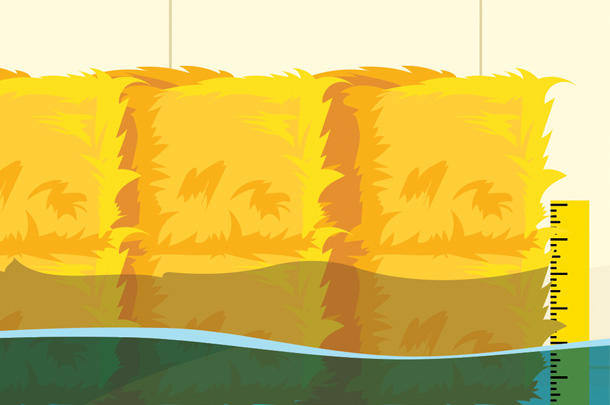Flooded hay
- Mold growth is the biggest concern in hay that has been standing in water and/or heavily rained on. Mold growth throughout the bale is a concern because it consumes nutrients in the hay and reduces its feeding value. Additionally, some mold species can produce mycotoxins. Not all species of mold produce toxins, but it is hard to distinguish whether the mold in your hay will cause toxicity issues. Therefore, it is better to err on the side of caution. Additionally, large amounts of mold can cause respiratory problems.
- Although it is not recommended, if you do choose to try to feed this hay, roll out the entire bale to allow cattle to select what they consume. They may or may not eat any of the hay depending on damage and other forage options.
- In addition, in some areas, contamination with petroleum products, pesticides or biological contaminates could be a concern with flooded hay.
- Do not feed hay that has mold production throughout the bale or that has been exposed to any contaminates that could be toxic to livestock. To dispose of this hay, it can be spread out in bare spots in pastures to allow for recycling of nutrients (e.g., N, P and K), used in a compost or distributed in areas with erosion issues. Spreading hay in bare spots or less productive areas of the pastures will also add organic matter to these areas and generally increase future forage production.
- Do not dump this hay into a creek beds, ponds or other bodies of water. Large amounts of hay dumped in a pond may deplete oxygen levels, killing any aquatic life.
- Regardless of how hay is disposed of, make sure to remove string or net wrap and dispose of properly. This waste could be detrimental if consumed by livestock or wildlife.

llustration by Kristen Phillips.
Rained-on hay
- If the bales are completely saturated and are not allowed to dry out before mold production, do not feed. However, if hay was unrolled and allowed to dry out quickly before any mold production, it may be safe to feed.
- Wet hay can be fed for a couple of days before mold production.
- Limited rainfall will cause outside damage to the bale. Break open a few bales to see how saturated the bale is. If damage is limited to the outside layers, the remained of the bale should be safe to feed.

llustration by Kristen Phillips.
Hay stored in a barn
- If the hay was submerged, document or mark the height of the water.
- Separate out the hay that was submerged or got wet from any dry hay. The dry hay could absorb moisture from the wet hay leading to more loss of valuable forage.
- Evaluate the bales on the outside edge of your storage to check for any moisture that may have occurred with windblown rain.
- If you are concerned about spontaneous combustion of wet hay, it is best to move the damaged hay out and away from any structures.

llustration by Kristen Phillips.
Additional notes
- Document any damage with photographs, number of bales damaged and any other information. Regulations and programs vary, but this information may be useful for tax, insurance or disaster assistance purposes. Visit with a CPA to determine if loss can be documented on your taxes.
- Please contact an extension beef cattle specialist or a ruminant nutritionist if you have any questions about feeding hay that was damaged.














